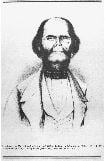
Nicholas Chevalier, 1828–1902. Portrait of William Buckley, drawn from a portrait by Ludwig Becker, engraved on wood by F. Grosse. Engraved surface 5½″ × 4½″. The Australian Newsletter, August 1857. La Trobe Library Collection.

Frontispiece to The Life and Adventures of William Buckley, by John Morgan, Hobart, 1852. F12813. Lithographer probably Ludwig Becker (1808–1861). Page surface 7½″ × 5″.
Illustration 1. | |
William Buckley (c.1780–1856), born near Macclesfield, Cheshire, England, is known to Australians as the “Wild White Man”. Transported to Australia in H.M.S. Calcutta in 1803 for having received stolen goods, he escaped from the temporary settlement at Port Phillip and was left behind when the settlement was abandoned. He lived for nearly 32 years among the blacks before surrendering himself in 1835 when the white people returned to settle. He died in Hobart in 1856. The Life and Adventures of William Buckley by John Morgan, Hobart, 1852, F12813, is the best of several biographies. A German edition was published in 1964, a Russian edition in 1967 and a second Australian edition, edited by C.E. Sayers, in Melbourne, 1967. The Australian Dictionary of Biography, Vol. 1 (Buckley entry), gives further details and bibiography. | |
Ludwig Becker, 1808–1861, born at Darmstadt, Germany. Further details in the Australian Encyclopedia; the forthcoming Australian Dictionary of Biography, Vol. III, includes an extensive bibliography of source material on Becker. | |
Sir William Denison, Varieties of Vice-Regal Life, London, 1870, F9107, p. 170. | |
The painting was purchased at Leonard Joel's auction rooms, Melbourne, in September 1967. The vendor was J.E. Pyke Esq., son of W.T. Pyke, author of The Story of William Buckley, Melbourne 1889, F14548. About five years ago Mr Pyke told me that the painting had been hanging in a back room in his home in Denham Street, Hawthorn for many years. About sixty years ago an unknown friend presented it to his father because of the latter's interest in Buckley. He recently confirmed that the late Mr W.T. Pyke had always said it was copied for the frontispiece of Morgan's Life, but he did not know the artist. | |
For an interesting re-assessment of Morgan's narrative see C.M. Tudehope, “William Buckley”, Victorian Historical Magazine, XXXII, iv, pp. 216–236, May 1962. See also Mrs Tudehope's review of Morgan's Life, ed. C.E. Sayers, ibid, XXXVIII, iii, pp. 160–161, August 1967. | |
C.E. Sayers, op. cit. p. xx. | |
Illustration 2. | |
Clifford Craig, The Engravers of Van Diemen's Land, Hobart, 1961, p. 80. Dr. Craig reproduces the Buckley lithograph on p. 99 but does not ascribe it to anyone. | |
Illustration 3. | |
Australian Encyclopedia, Sydney, 1958, Vol. VII, p. 102. | |
Australische Monazeitung, No. 1, February, 1862, Melbourne. | |
Denison, op. cit., pp. 170–180. Lady Denison's diary entries refer to the lighter side of life with Ludwig Becker, Sir William writes of Becker's ability as a scientist. | |
Op. cit., plate 44, p. 145. Although she has not seen the original, I asked Dr. Ursula Hoff whether she thought this cartoon could have been by Becker. Dr. Hoff thought it unlikely because the line of the cartoon appears to be more sophisticated than any of Becker's original work that she has seen. | |
The Australian Newsletter No. XIV, August, 1857, Melbourne. | |
Morgan, op. cit., pp. 144–5: “About this time I was visited at Mr. Cutts' by one of my old shipmates in the Calcutta, who had become a wealthy and respectable settler, near the Green Ponds, about thirty miles from Hobart Town. After a few days, and he had settled his business, I accepted an invitation to accompany him to his home, where I was hospitably entertained more than three weeks; when, being tired of an indolent life, I begged my friend to make interest with his Excellency Sir John Franklin, so that I might have employ. My friend lost no time in acceding to my wishes; and, in a few days I was directed to call at Government House at an early hour, and had the honour to be introduced to Sir John and Lady Franklin, and to several gentlemen who were breakfasting there. Numerous were the questions they put to me, and amongst the rest was, what I wished on my own account? I replied, a small allotment of land! His Excellency said he could not grant land, but that he would see what could be done in the way of finding me employment.” My own check of Calcutta convicts shows that the old shipmate would have been Joseph Johnson, the only one settled at Green Ponds who fits this description. For further information on Joseph Johnson, see Journals of the Land Commissioners for Van Diemen's Land, 1826–28, ed. Anne McKay, Hobart, 1962. | |
Chevalier does not appear to have visited Tasmania until January 1868 when he travelled as an artist with H.R.H. the Duke of Edinburgh. William Archer's Journal, 16 January 1868, the Archer Papers, MS. Collection, University of Tasmania. | |
The Australian Newsletter, XII, June 1857, Melbourne, etc. | |
Becker, Ludwig, Men of Victoria, Part I, Melbourne, 1856. F6854. (Part II did not appear). | |
Ibid. Preface. | |
Hobart Town Courier, 10 October 1851, p. 3 c.3. | |
Also in the La Trobe Library. |